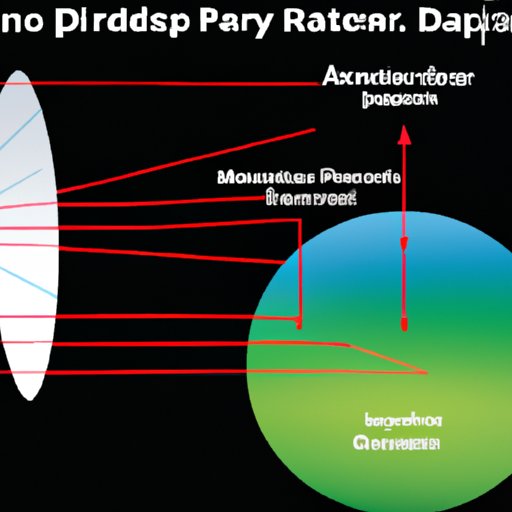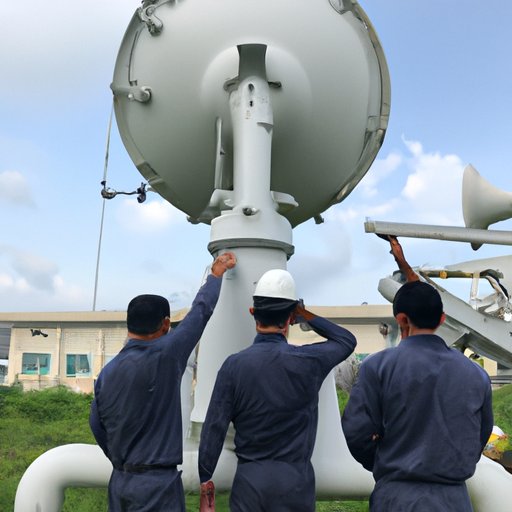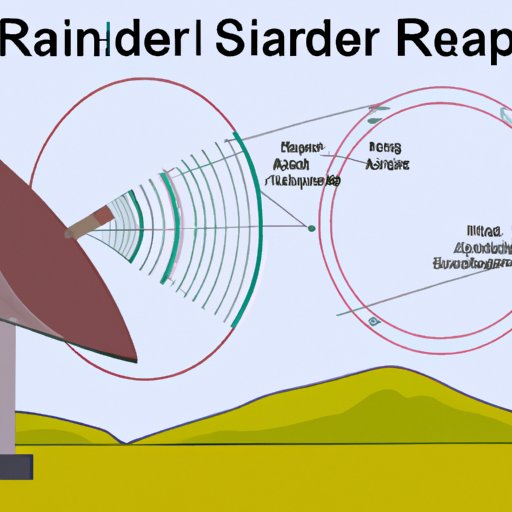Introduction
Doppler radar is a type of radar technology that is used to detect motion and measure the speed of objects. It is often used for tracking weather patterns, analyzing air traffic, and many other applications. In this article, we will explore the physics of Doppler radar, the mechanics behind the technology, and some of the most common uses for Doppler radar systems.

Exploring the Physics of Doppler Radar: How It Works
When it comes to understanding how Doppler radar works, it helps to have a basic knowledge of wave theory. Wave theory states that energy is transmitted through a medium in the form of waves. These waves can be characterized by their frequency and wavelength.
Frequency refers to the number of waves that pass a given point in a certain amount of time. Wavelength is the distance between two consecutive points on a wave. Both of these properties are important when it comes to understanding how Doppler radar works.
When a wave encounters an object, it can be reflected or refracted. Reflection occurs when the wave hits the object and bounces back in the opposite direction. Refraction occurs when the wave passes through the object and changes direction.
The Doppler effect is a phenomenon that occurs when a wave interacts with a moving object. When a wave reflects off of a moving object, its frequency and wavelength change. This is known as the Doppler shift. The Doppler shift can be used to measure the speed of the moving object.

The Mechanics Behind Doppler Radar Technology
Doppler radar systems are composed of several components that work together to generate and analyze radar signals. The main components of a Doppler radar system are a transmitter, receiver, antenna, and signal processor.
The transmitter generates a radar pulse that is emitted from the antenna. The pulse is sent out in all directions and then reflected off of any objects in its path. The reflected pulse is picked up by the receiver and sent to the signal processor. The signal processor analyzes the data and determines the location, speed, and direction of the objects.
The Doppler shift can be used to measure the speed of the objects. By measuring the difference in frequency between the outgoing and incoming pulses, the signal processor can calculate the speed of the objects.
How Doppler Radar Helps Track Weather Patterns
Doppler radar is often used to track and analyze weather patterns. Radar meteorology is the study of weather patterns using radar data. Doppler radar can be used to measure wind speed, rainfall, and other meteorological phenomena.
Weather analysis involves using Doppler radar data to make predictions about future weather conditions. By analyzing current weather patterns, meteorologists can make more accurate predictions about future storms and other weather events.
Storm prediction is an important application of Doppler radar. Meteorologists use Doppler radar data to track and predict the paths of severe storms. By monitoring the speed and direction of the storm, they can provide information to help people prepare for the storm’s arrival.
A Comprehensive Guide to Doppler Radar Operation
Setting up a Doppler radar system requires careful planning and consideration. The system must be positioned correctly in order to achieve optimal performance. Once the system is set up, it must be calibrated to ensure accurate readings.
Monitoring and analyzing data is an important part of Doppler radar operation. Data must be monitored continuously to ensure accuracy and reliability. Data must also be analyzed in order to identify trends and make predictions.
Interpreting Doppler radar readings can be difficult, but it is essential for making accurate predictions. Meteorologists must be able to interpret the data in order to make reliable forecasts.

An Introduction to Doppler Radar and Its Applications
Doppler radar has many uses, both in the military and civilian sectors. Military uses include tracking enemy aircraft and missiles, detecting submarines, and monitoring threats. Commercial and industrial uses include traffic control, search and rescue operations, and surveillance.
Medical applications of Doppler radar include imaging of the brain, heart, and other organs. Ultrasound is one example of a medical application of Doppler radar.
Understanding Doppler Radar Technology: What it Does and How it Works
Doppler radar is a powerful tool for tracking and analyzing weather patterns, monitoring air traffic, and many other applications. By understanding the physics of Doppler radar and the mechanics of how it works, users can get the most out of this technology.
The benefits of Doppler radar include its ability to accurately measure the speed and direction of objects. It is also relatively easy to set up and use. However, there are some limitations to Doppler radar, such as its limited range and sensitivity.
Conclusion
Doppler radar is a versatile and powerful tool for tracking and analyzing motion. By understanding the wave theory behind Doppler radar, the mechanics of how it works, and some of the most common uses for this technology, users can get the most out of this technology. Doppler radar is a valuable tool for meteorologists, military personnel, and others who need to monitor and analyze motion.
In summary, Doppler radar is a type of radar technology that uses the Doppler effect to measure the speed and direction of objects. It is composed of several components that work together to generate and analyze radar signals. Doppler radar is used in many different applications, including weather analysis, air traffic monitoring, and military operations.
By understanding the principles of Doppler radar and the mechanics of how it works, users can get the most out of this technology. Doppler radar is a valuable tool for those who need to monitor and analyze motion.
(Note: Is this article not meeting your expectations? Do you have knowledge or insights to share? Unlock new opportunities and expand your reach by joining our authors team. Click Registration to join us and share your expertise with our readers.)
